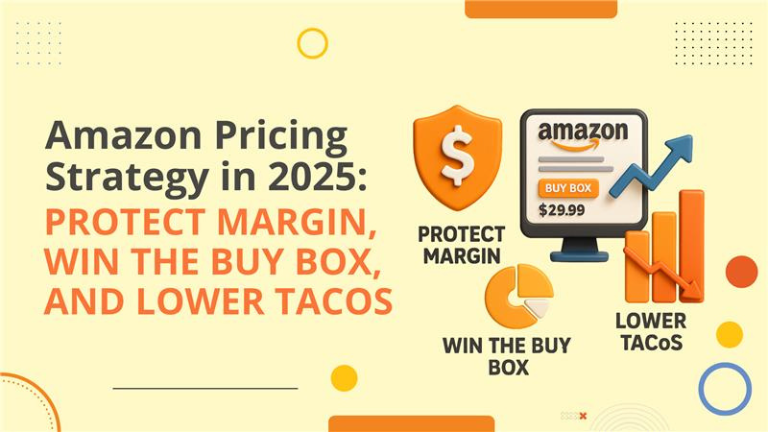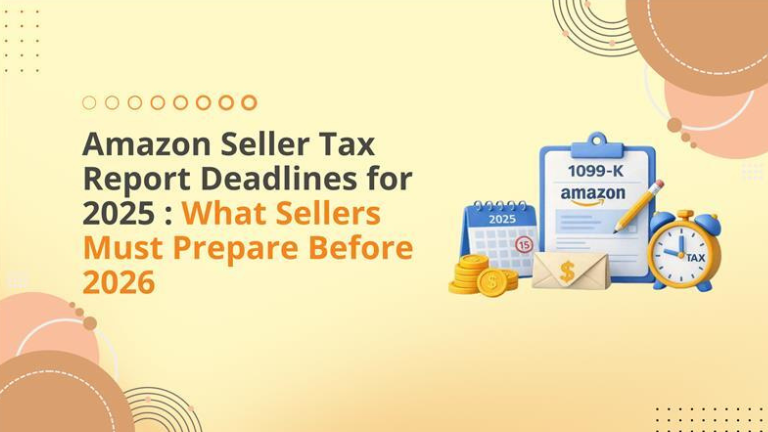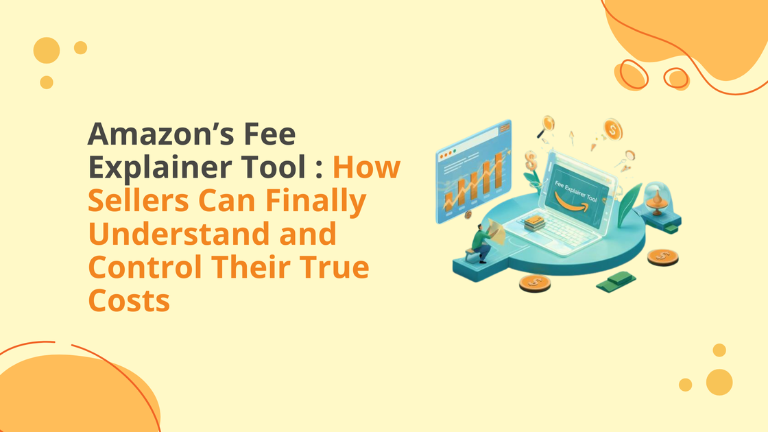Contents
Buy Box Factors & Myths
In 2025, “pricing” is not just about being low — it’s about being strategic. Many Amazon Sellers believe you need the absolute lowest price to win the Buy Box (now called the Featured Offer), or that cutting prices aggressively always increases volume. Both are myths. What really counts are a combination of pricing + seller performance + fulfillment + inventory factors. Understanding what the algorithm values now can protect margins while improving Buy Box win rates and reducing TACoS (Total Advertising Cost of Sales).
Key Factors for Buy Box / Featured Offer
Here are the current reality checks—what Amazon really takes into account in 2025, and common myths to avoid. (Sources: Amazon Seller Central; Automate Pricing & Featured Offer guidance)
- Amazon considers total landed price (item price + shipping) when deciding the Featured Offer, not just the price tag.
- Having the lowest price does not guarantee Featured Offer; performance metrics like order defect rate, shipping speed, valid tracking, cancellation rate, late shipment rate also play big roles.
- Inventory availability matters. Being out of stock or low stock can disqualify or reduce your competitiveness
- The fulfillment method (especially FBA or Seller-Fulfilled Prime) still gives advantage due to reliability, shipping speed, customer trust.
- Myth: Constantly undercutting competitors is the only way to win. Reality: aggressive price wars can erode margins, hurt profit, and sometimes even degrade performance metrics. Smart repricing with guardrails is safer.
- Tools like Amazon’s Automate Pricing allow you to define pricing rules tied to competitor prices, Featured Offer changes, external price references, etc. These enable continuous competitiveness without manual intervention.
Building Rule Sets Tied to COGS + Target Margin; Syncing with PPC Status/Budget Rules
To protect margin while improving Buy Box wins and lowering TACoS, your pricing strategy should be rule-based and integrated with PPC/budget decisions. Here’s how:
- Define your cost structure
• Calculate COGS + all associated fees (Amazon fees, FBA fees, shipping, returns) + overhead.
• Determine your minimum margin threshold that you will not go below, even if losing the Buy Box temporarily. - Set Repricing Rules Using Automate Pricing
• Use Amazon Automate Pricing to create rules that match or stay slightly above Featured Offer price, but with constraints.
• Use rules for “Competitive Featured Offer,” “Competitive Lowest Price,” or “External Price Match” depending on SKU/category
• Set price floors & ceilings to protect margins. - Sync Pricing with PPC / Ad Budgets
• For ASINs where PPC spend is high, ensure pricing supports the ad investment — i.e. margin after ad spend remains acceptable.
• Use bulk files or automation to align bid increases or budget ramps when pricing is favorable (e.g. you are Featured Offer or close to it).
• Conversely, if pricing is weak (e.g. high cost, low win rate), reduce PPC spend or pause campaigns to avoid high TACoS. - Monitor “Pricing Health” & Seller Metrics Closely
• Use Amazon’s Pricing Health dashboard to find ASINs which are ineligible for Featured Offer or priced outside competitive ranges.
• Track metrics like Buy Box win rate, margin erosion, TACoS, inventory turnover, shipping/shipment performance, ODR, cancellation rate.
A 14-Day Test Plan
Here’s a hands-on plan you can roll out over 14 days with a pricing template to test changes and measure impact.
- Day 1
• Select test SKUs (top 20% by sales volume or margin).
• Record baseline metrics: Buy Box % (Featured Offer %), sales volume, TACoS, and margin. - Day 2-3
• Create Automate Pricing rules for each SKU.
• Use rule types like Featured Offer match, external price, or competitive lowest.
• Set price floors and ceilings to protect margin. - Day 4-5
• Review fulfillment setup (shift to FBA or improve shipping if needed).
• Optimize logistics to raise Featured Offer competitiveness. - Day 6-8
• Sync pricing changes with PPC budgets and bids.
• Increase ad bids where SKUs are competitive in Featured Offer.
• Cut or pause PPC where SKUs lose Buy Box to prevent high TACoS. - Day 9-11
• Monitor Pricing Health dashboard and Featured Offer eligibility.
• Adjust pricing rules or floors if Buy Box win rate or margins slip. - Day 12-14
• Evaluate test results: changes in Featured Offer %, TACoS, margin, and sales volume.
• Scale up successful pricing rules; stop those that eroded profit.
Pricing Template Components:
-
- SKU
- Current Price, Current Buy Box %
- COGS + all fees
- Minimum Acceptable Margin %
- Rule Type (e.g., Match Featured Offer, Competitive Lowest, External Price)
- Price Floor, Price Ceiling
- Fulfillment method (FBA vs FBM)
- PPC Budget / Bid Modifier tied to pricing status
How This Helps Sellers Protect Margin, Win the Buy Box, Lower TACoS
- By having rules with price floors, you avoid margin erosion even when competing aggressively.
- Winning Featured Offer more often increases visibility, which means PPC & organic both perform better, so you need less ad spend per sale → lower TACoS.
- Syncing pricing and PPC ensures your ad spend doesn’t chase sales that cost too much, so profitability improves.
- Clear metrics from the 14-day test give you data to know what works before scaling, reducing risk.
How Big Internet Ecommerce Can Help
If you need hands-on assistance aligning your pricing strategy with your PPC, bids, and bulk operations, check out our Amazon PPC optimization service. We help Amazon Sellers set up pricing rules, synchronize bids, and build resilient margin-focused strategies.
Ready to build pricing rules that protect margin, win the Featured Offer, and drop your TACoS?
Book a pricing consult with us, and we’ll map out your test roadmap + pricing strategy.
Follow Big Internet Ecommerce (BIE) on Instagram & LinkedIn to stay updated with the latest trends in Amazon selling.






